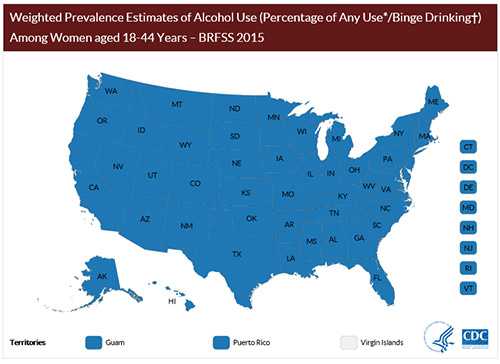Data & Statistics
Prevalence of FASDs
- We do not know exactly how many people have fetal alcohol spectrum disorders (FASDs). Several different approaches have been used to estimate how many persons are living with FASDs in the population. FASDs include several diagnoses related to exposure of the baby to alcohol during pregnancy. More specifically, fetal alcohol syndrome (FAS) is the most involved diagnosis, used when several physical and developmental abnormalities are present (see Facts about FASDs).
- Using medical and other records, CDC studies have identified 0.2 to 1.5 infants with FAS for every 1,000 live births in certain areas of the United States.1 The most recent CDC study analyzed medical and other records and found FAS in 0.3 out of 1,000 children from 7 to 9 years of age. 2
- Studies using in-person assessment of school-aged children in several U.S. communities report higher estimates of FAS: 6 to 9 out of 1,000 children. 3,4
- Few estimates for the full range of FASDs are available. Based on community studies using physical examinations, experts estimate that the full range of FASDs in the United States and some Western European countries might number as high as 2 to 5 per 100 school children (or 2% to 5% of the population).3,4
Cost of FASDs
- The lifetime cost for one individual with FAS in 2002 was estimated to be $2 million. This is an average for people with FAS and does not include data on people with other FASDs. People with severe problems, such as profound intellectual disability, have much higher costs. It is estimated that the cost to the United States for FAS alone is over $4 billion annually. [Read summary]
State-level estimates of alcohol use among women
- Estimates of alcohol use among women of childbearing age vary from state to state. View your state’s alcohol consumption rate in 2015
- Data come from the Behavioral Risk Factor Surveillance System (BRFSS), a telephone survey that tracks national and state-specific self-reported health risk behaviors of adults, 18 years and older, in the United States.
Alcohol use and binge drinking among women of childbearing age – United States, 2011-2013

- About half of nonpregnant women reported any alcohol use* and about 1 in 5 reported binge drinking† in the past 30 days.
- Among pregnant women, 1 in 10 reported any alcohol use and 1 in 33 reported binge drinking in the past 30 days.
- Among pregnant women, the highest prevalence of any alcohol use was among those who were
- 35-44 years
- college graduates
- not married
- Among women who reported binge drinking in the past 30 days, pregnant women reported an average of 4.6 binge drinking episodes. This was higher than the average of 3.1 such episodes reported by nonpregnant women. The intensity (largest number of drinks consumed per episode) of binge drinking did not differ between pregnant and nonpregnant women.
- Among nonpregnant women who reported binge drinking, those aged 18-20 years reported the highest frequency and intensity compared to other age groups.
About this Study
- The study uses data collected from the Behavioral Risk Factor Surveillance System (BRFSS), a state-based, landline and cellphone survey of the U.S. population.
- To estimate alcohol use and binge drinking for women aged 18-44 years, data from the 2011-2013 BRFSS were analyzed for all 50 states and the District of Columbia.
- Among binge drinkers, the frequency (number of binge drinking episodes in the past 30 days) and intensity (largest number of drinks consumed per episode) of binge drinking was also estimated.
*Any alcohol use was defined as having at least one drink of any alcoholic beverage in the past 30 days
† Binge drinking was defined as having consumed four or more drinks on an occasion at least one time in the past 30 days.
Alcohol Use Data Sets
Behavioral Risk Factor Surveillance System (BRFSS): This telephone survey tracks national and state-specific health risk behaviors of adults, aged 18 years and older, in the United States. The BRFSS is administered and supported by the Division of Adult and Community Health, National Center for Chronic Disease Prevention and Health Promotion, CDC.
National Health Interview Survey (NHIS): The NHIS is a multi-purpose nationwide household health survey of the U.S. civilian noninstitutionalized population conducted annually by the National Center for Health Statistics (NCHS), CDC, to produce national estimates for a variety of health indicators.
National Survey on Drug Use and Health: This survey provides information on the prevalence, patterns, and consequences of alcohol, tobacco, and illegal drug use and abuse in the general U.S. population, 12 years and older. It is conducted by the Substance Abuse and Mental Health Services Administration.
Alcohol-Related Disease Impact (ARDI)(https://www.cdc.gov/ardi/index.htm): This software, supported by CDC’s National Center for Chronic Disease Prevention and Health Promotion, generates estimates of alcohol-related deaths and Years of Potential Life Lost (YPLL) due to alcohol consumption.
References
1 CDC. Fetal alcohol syndrome-Alaska, Arizona, Colorado, and New York, 1995-1997. MMWR Morb Mortal Wkly Rep. 2002;51(20):433-5. [Read article]
2 CDC. Fetal Alcohol Syndrome Among Children Aged 7-9 Years – Arizona, Colorado, and New York, 2010. MMWR Morb Mortal Wkly Rep. 2015;64(3):54-57. [Read article]
3 May PA, Baete A, Russo J, Elliott AJ, Blankenship J, Kalberg WO, Buckley D, Brooks M, Hasken J, Abdul-Rahman O, Adam MP, Robinson LK, Manning M, Hoyme HE. Prevalence and characteristics of fetal alcohol spectrum disorders. Pediatrics. 2014;134:855-66. [Read summary]
4 May PA, Gossage JP, Kalberg WO, Robinson LK, Buckley D, Manning M, Hoyme HE. Prevalence and epidemiologic characteristics of FASD from various research methods with an emphasis on recent in-school studies. Dev Disabil Res Rev. 2009;15:176-92. [Read summary]
- Page last reviewed: June 6, 2017
- Page last updated: June 6, 2017
- Content source:



 ShareCompartir
ShareCompartir
